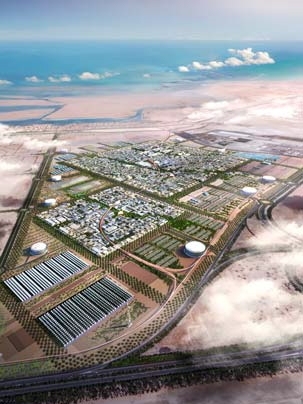Abu Dhabi is a tiny nation with huge reserves of oil and, as a result, a lot of wealth. But this Persian Gulf emirate is taking the long view, and planning right now for a future beyond oil.
The most dramatic piece of Abu Dhabi's futuristic planning is its creation of a whole new city from scratch, centered on an institute of technology modeled after, and created in collaboration with, MIT. The new city, Masdar, is perhaps the most ambitious attempt in the world today to create a community with a total net energy use of zero--without sacrificing any of the amenities of modern technology. Carbon emissions and waste output are also intended to be kept at or near zero.
The city, designed to house 50,000 people with the Masdar Institute of Science and Technology at its center, will be completely car-free, with walkways and personal transportation systems instead of roads and parking garages. Some of the walkways will be topped with solar panels, which will offer shade from the blistering tropical sun while also providing electricity for the city.
"Every building will be designed and constructed to provide a model for sustainable living and working," the Masdar Institute's web site declares. Power will come from photovoltaic panels and surrounding wind farms. And the city will be built with the "fullest use of innovation in energy-efficiency, sustainable practices, resource recycling, biodiversity, transportation and green building standards," they say.
"It's a pretty exciting project," says MIT's Charles Cooney, professor of chemical engineering and a member of the Masdar Initiative's executive committee. "The university will be living inside many of the experiments it is conducting."
And that will provide a unique opportunity both for education and for research on a full-scale, integrated approach to energy efficiency and sustainability, Cooney says. "There are a lot of things going on around the globe in the way of future energy projects--alternative fuels, energy efficiency, alternative energy devices. But they're not typically all going on in the same place at the same time." Masdar, he says, is "bold, it's big and it's quite unique."
The whole could be much greater than the sum of its parts, he suggests. "You not only get to do experiments around the individual alternative energy ideas, but you get to do experiments around the system as a whole. One of the biggest challenges is the systems engineering. People underestimate how difficult it is to get everything working together."
MIT will maintain a close association with the Masdar Institute, whose faculty will spend a year here before beginning their teaching there. But the involvement with the creation of the new city and campus is more limited.
Some of the initial ideas for the zero-energy plan came from the MIT collaboration, says Leon Glicksman, professor of building technology and mechanical engineering and director of MIT's Building Technology Program. "We did work with them when they were evaluating proposals for the architecture," he says, but now "they're on a really fast track for construction," so the British architectural firm, Foster + Partners, which did the principal design work, is taking the lead.
Once the project is built, MIT will have an ongoing role in monitoring the actual energy performance of the city, Glicksman says. And that could provide an extraordinary opportunity for students to learn about the potential for such large-scale integrated approaches to innovative energy production and use.
The Masdar Institute itself, at the heart of the new city, is being modeled very closely on MIT, says Fred Moavenzadeh, the James Mason Crafts Professor of Systems Engineering and Civil and Environmental Engineering. "MIT is really a research-driven institution. The education here is highly interactive with the research," he says. "That style of education is very much missing in most countries," but plays an important role in fostering innovative ideas that can spur a nation's economic development, he says.
Moavenzadeh says that "energy and environment are at the frontiers of research," and so it makes sense for the new institute to put those at the center of its program--and its setting. But while the program is modeled on MIT, he says, it is also essential that its programs be oriented toward the local environment and local needs.
While details of the long-term relationship remain to be determined, Cooney says, once it is up and running, "it hopefully will become an incredibly significant opportunity for MIT faculty and students."
Key people involved in the Masdar Initiative, from MIT and from Abu Dhabi, will present details of the project in a May 5 symposium in the Wong Auditorium. Details of the meeting are at http://tinyurl.com/4jwy26.
In addition, a "Masdar Student Day" will be held on May 6 to outline graduate engineering educational opportunities in Abu Dhabi. The event takes place from 12:30 to 4:45 p.m. in Bartos Theater.
A version of this article appeared in MIT Tech Talk on April 16, 2008 (download PDF).






